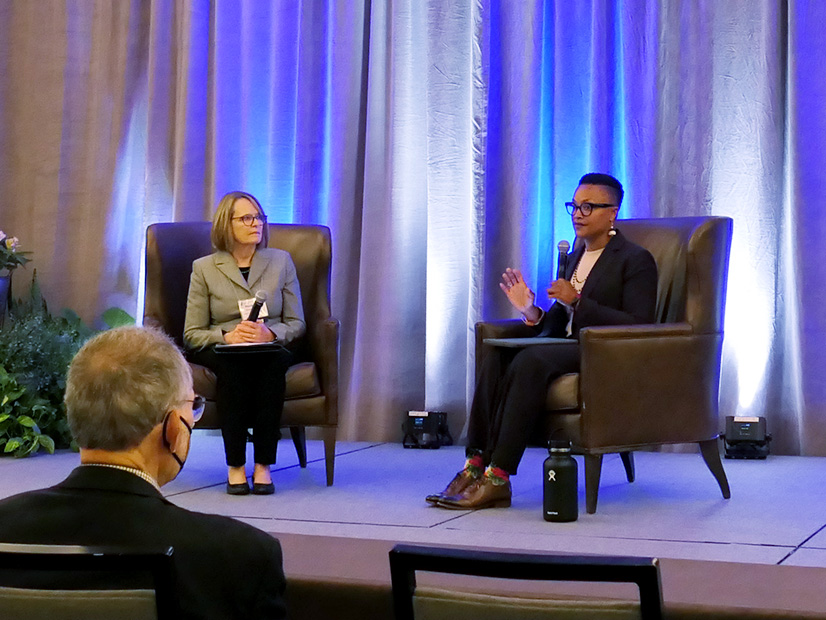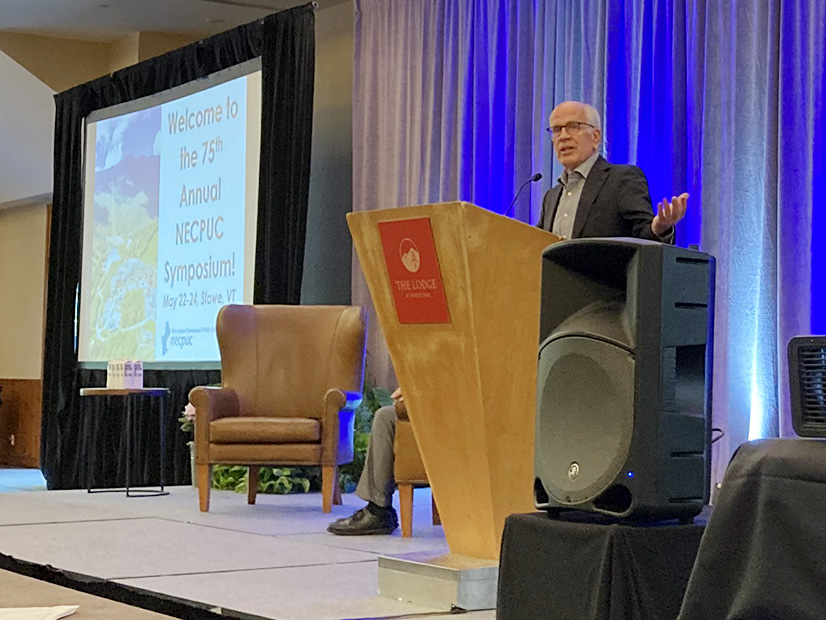
STOWE, Vt. — Transmission planning, equitable energy siting, and making the most of billions in federal funding were among the key topics as regulators, industry members, and energy experts gathered at Stowe Mountain Resort for the New England Conference of Public Utilities Commissioners’ (NECPUC) 75th annual symposium last week.
“We can have a better, more efficient permitting process without compromising environmental or social justice values,” said U.S. Sen. Peter Welch (D-Vt.), opening the conference as legislators in Washington continued their negotiations over permitting rules amid debt ceiling talks. “A lot of environmentalists really want to accelerate the timeline when it comes to clean energy projects … that’s one area where I think there’s some potential for us to make some progress.”
Welch said that building clean energy projects at the local level will be a far more difficult task than drafting federal legislation. But he expressed hope that successful projects early on could help build broader support for additional infrastructure.
“It’s not a one-size-fits all deal that we have here,” Welch said, citing the need to balance affordability, clean energy and reliability. “You guys have your work cut out.”
A Focus on Equity
Using the clean energy transition to address historical environmental injustice was a recurring theme in many of the symposium’s panels and discussions.
“I see energy as the Trojan horse to usher in equity,” said Shalanda Baker, director of the Office of Economic Impact and Diversity at the U.S. Department of Energy. Baker spoke about how she grew up living with energy insecurity and how low-income families are frequently forced to choose between energy, food and medicine.
“It’s a matter of life and death for so many households,” Baker said.
 U.S. Sen. Peter Welch (D-Vt.) | © RTO Insider LLC
U.S. Sen. Peter Welch (D-Vt.) | © RTO Insider LLC
Baker urged better engagement with environmental justice communities and said states should look at different energy models, including community ownership programs. She called on regulators to work to right the wrongs of historical energy siting, where the greatest burdens of infrastructure have typically fallen on low-income neighborhoods and communities of color.
While frontline communities have dealt with increased pollution from energy infrastructure, they often simultaneously spend a larger portion of their income on energy bills, are often more susceptible to climate impacts such as extreme heat, and have the least access to clean energy programs related to rooftop solar, storage and energy efficiency, Baker told the symposium.
“These are not accidents; we’ve made these choices as policymakers,” Baker said. “As you are engaging utilities on how they are siting facilities, we have to think about this through the social lens. … If we’re not careful and vigilant, we will replicate that inequality.”
David Cash, EPA’s New England regional administrator, also emphasized the role regulatory agencies have historically played in perpetuating legacies of environmental harm.
“There is a moment now unlike any other moment that I’ve lived through, unlike any other I think that most of you have lived through,” Cash said. “And part of that has to go hand-in-hand with environmental justice and equity. If you look at how our current system is … Black children have asthma rates that are twice as high as white children. Two-thirds of fossil fuel plants in the country are located in low-income and Black and brown communities. That’s how the fossil fuel system has been set up, and it’s partly due to agencies like mine, EPA, [which have] permitted those fossil fuel facilities for the last five decades.”
Transmission Planning
With clean energy projects making up the vast majority of New England’s interconnection queue, “we have to go from a reliability-driven planning process to a clean energy integration process, where transmission is used to reduce total costs, not just add costs,” said Johannes Pfeifenberger, a principal at the Brattle Group. He said that transmission could cut customer rates by reducing generation integration costs and bringing cheaper resources to the grid.
On interconnection, Pfeifenberger said that New England is in a better place than most of the country but said that more needs to be done to meet the region’s ambitious clean energy standards.
“Planning is so important: We should already know where we want to connect the 9 GW of offshore wind that are already committed to by the states; we should know where we interconnect the next 20 GW of wind; we should know how to get 5 GW of onshore wind from Northern Maine to the rest of New England,” Pfeifenberger said.
Pfeifenberger cited the “connect and manage” interconnection process used by Texas and the U.K., where projects are connected to the grid quicker — potentially reducing the interconnection process by several years — but face increased risks of curtailment and congestion.
“We don’t have any congestion on the grid right now,” Pfeifenberger said. “That tells us we can put a lot more energy on it. We want to accept some congestion, as it’s cost effective.”
Robert Ethier, vice president of system planning at ISO-NE, responded that “interconnecting people as quickly as possible comes with its consequences,” saying it is important to ensure that the grid can handle additional resources.
“Just getting people interconnected is not the only metric we need to worry about,” Ethier said. “There’s a balance that needs to be struck there.”
Ethier highlighted the potential of grouping projects together in areas with lots of interconnection to help speed up the process, as well as moving from a first-come, first-served process to a first-ready, first-served process.
Using Federal Funding
Speakers throughout the conference emphasized the importance of states making the most of the federal funds available through the Inflation Reduction Act and the Infrastructure Investment and Jobs Act.
Cash noted that EPA has about $100 billion to distribute to states, communities and companies for climate investments and programs. He said that while state utility regulators will not receive this funding themselves, they will play an essential role in “creating the regulatory landscape — the rules — that will allow that federal funding to be doubled, tripled, or quadrupled [by] private sector investment.”
Hank Webster, deputy commissioner for energy at the Connecticut Department of Energy and Environmental Protection, highlighted the $1.25 billion hydrogen hub application submitted by a coalition of Northeast states, companies, and organizations as a means to address winter grid reliability. (See Vermont Joins Northeast Clean Hydrogen Hub.)
“That’s a really exciting opportunity to take a big step forward,” Webster said. “These are all generational investments that are necessary and are going to transform our energy systems.”
Webster also spoke about some of the difficulties that states are facing in obtaining the new federal funding.
“Some of the challenges that we have are quick turnarounds between the notice of funding availability to when applications have to be in and all that, particularly on some of the bigger items like transmission planning,” Webster said.
Webster added that figuring out how to limit impacts of supply chain costs, high interest rates, and geopolitical risks will be essential for making the most of the funding. He also advocated for additional flexibility on the income eligibility requirements on some of the funding opportunities, saying that states should be allowed to use more granular population data when available.

